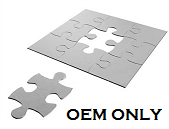
If you’re looking to purchase replacement parts that will offer peace of mind, value, and great customer service, OEM (Original Equipment Manufacturer) parts are the best choice. Here are 5 reasons why:
PEACE OF MIND
Because OEM parts are exactly the same as the original parts your manufacturer used, you get the peace of mind that your supply chain won’t suffer expensive downtime down the line because of a defective part. That means you can stop worrying about problems that might occur later on, and start focusing on your business.
WARRANTY RETENTION
Non OEM parts have NO manufacturer's warranty. Manufacturers cannot place a guarantee on the performance of parts that aren’t OEM, so while aftermarket replacement parts are an option, they can often void manufacturer warranties—which in turn can decrease the value of your machinery. And, the replacement part won't be covered by the manufacturer's warranty either. Check your manufacturer’s warranty before purchasing replacement parts to ensure you don’t make a costly mistake on parts that aren’t OEM.
SAFETY
When you choose OEM replacement parts, you can be 100% sure you’re getting the exact same parts the manufacturer uses, which also means you can be 100% sure they’re up to par with the manufacturer’s safety standards. Aftermarket part manufacturers can’t always guarantee the same, since their regulations may be different from the original supplier.VALUE
Even though OEM parts are often not the least expensive option, they do offer unbeatable value. Again, because they are exact replicas of the parts that were originally used by the manufacturer, their benefits include better durability and optimal performance in the long run—which means less money spent on replacement parts later.
REDUCED DOWNTIME
Most major retailers, including online stores, keep OEM parts in their inventories at all times—which means you can eliminate the hassle of searching for the right part or waiting for them to be shipped in an emergency situation. Plus, because retailers are so familiar with OEM replacement parts, they’ll be able to help you get exactly what you’re looking for.
Why should you insist on Genuine OEM Parts?
- Maintain Manufacturer's Warranty Coverage
- Maintain UL, NSF & Local approvals
- Exact "drop-in" replacements
- Exact manufacturer electrical specifications and connections
- Designed to meet manufacturers' life cycle design specification
- Preserve equipment performance
- Protect your equipment and repair investment
Everyone understands how critical the availability of spare service parts is to the operational efficiency and uptime for any piece of equipment to a business. When equipment breaks down, end users typically focus on the initial cost of the part. In their decision making, customers generally fail to consider the true cost of repair and the long term cost of ownership. Cost of unplanned outages due to inferior parts and components not functioning per the manufacturer’s equipment specification all make up the true cost of ownership when a repair is made, For example, if a generic spare part functions at even 95% of the original part’s efficiency, has a lifespan that is 80% of the OEM part, end users risk losing thousands of dollars in sales due to additional unit downtime while spending more for the utilities to operate the equipment.
Beyond the immediate and long-term cost benefit analysis, use of non-OEM parts when servicing equipment can potentially impact agency listings and certifications including UL, CSA, NSF, an EnergySTAR. End users and service agents who utilize non-OEM parts that void an agency approval assume liability if an employee were to be injured by that piece of equipment resulting from a failure or impact from the non-OEM component.
The value of OEM parts is further enhanced with ever-increasing utility costs. EnergySTAR ratings are directly linked to the equipment and manufactured component specifications such that replacing energy efficient parts with non-OEM alternatives will invalidate the EnergySTAR compliance rating. Generic parts may be similar in form and function but OEM parts designs and specifications are integrated into the overall design of the equipment and guarantee peak equipment performance. Additionally, the loss in equipment performance will negatively impact product cycle times which could cascade to food quality, food safety and customer satisfaction.
As equipment becomes more sophisticated and intricate in design to maximize performance while minimizing footprint and utility consumption, systems design and the OEM components used in the manufacture and service of the equipment becomes more critical. Equipment complexity is escalating to provide end users the ability to do more with less. As this trend progresses, using non-OEM parts in equipment repairs will cause end users to forfeit the warranty because the impact on the functionality of the system by a non-compliant part could cascade to the performance of other components and cause premature failures, repeat visits, and further downtime.
OEM parts are the only way to ensure the equipment you invested in stays within its original, top working condition. For safety, liability protection, and to maintain approval ratings, replacement with OEM parts is key.